Rogue Valley Chorale’s Misa Azteca Concert
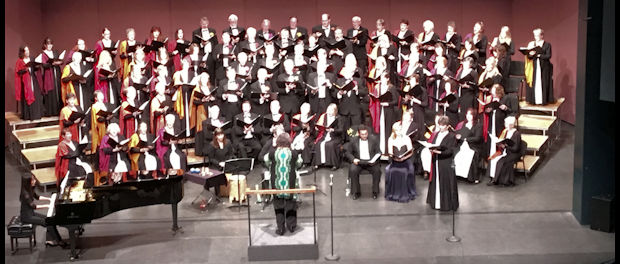 Music Director Laurie Anne Hunter leads Rogue Valley Chorale and pianist Mikiko Petrucelli, percussionist Theresa McCoy, Guitarist Grant Ruiz (partially obscured), and soloists tenor Ricardo Garcia (seated), soprano Katie Harman Ebner (seated) and Mezzo-soprano Janet O'Donovan (standing) during final movement (Ite Missa Est) of Joseph Julian Gonzalez's Misa Azteca during Rogue Valley Chorale's Misa Azteca Concert, March 12, 2016 at Craterian Theatre, Medford, OR
Music Director Laurie Anne Hunter leads Rogue Valley Chorale and pianist Mikiko Petrucelli, percussionist Theresa McCoy, Guitarist Grant Ruiz (partially obscured), and soloists tenor Ricardo Garcia (seated), soprano Katie Harman Ebner (seated) and Mezzo-soprano Janet O'Donovan (standing) during final movement (Ite Missa Est) of Joseph Julian Gonzalez's Misa Azteca during Rogue Valley Chorale's Misa Azteca Concert, March 12, 2016 at Craterian Theatre, Medford, OR
Chorale’s Misa Azteca: In Third Season, New Director Takes A New Approach and It’s Brilliant And Successful
– by Lee Greene
Laurie Anne Hunter succeeded Lynn Sjolund as Music Director of the Rogue Valley Chorale for the 2013-2014 season, following Dr. Sjolund’s retirement at the conclusion of the 2012-2013 season, after 40 years of leading the choral organization which he founded. It’s a tough act to follow. See, e.g., Lynn Sjolund hangs up his baton, Mail Tribune, Aug. 31, 2012, http://bit.ly/1MJbzBU:
“Hailed as genial, fun and the consummate professional, the 83-year-old Sjolund says the chorale’s performances of Bach’s long and complex Mass in B Minor were his highest achievements, along with Bach’s St. Matthew Passion and Mendelssohn’s ‘Elijah.’
‘They took a lot of rehearsing and expansion of our thinking . . . .’”
Ms. Hunter’s tenure leading the Rogue Valley Chorale commenced in her initial season, 2013-2014, with very modest deviations from the programming and repertoire adhered to under Dr. Sjolund, with three concerts: a typical annual Chorale Christmas concert – Christmas with the Chorale; a winter concert of show tunes and opera songs – Live at the Crate; and a spring concert of songs inspired by the season – Spring Splendor. During her sophomore season as music director, 2014-2015, Ms. Hunter began to imprint her original ideas and programming upon the Chorale’s offerings: the annual Christmas concert became “a multi-cultural extravaganza in story and song” instead of just the standard Christmas fare – Christmas Around the World; the Winter concert offered something truly new, “For the first time ever, all five choruses of the Rogue Valley Chorale Association present a combined concert” – Festival of Choirs; and with Ms. Hunter leading the Chorale on a 2015 summer tour of Spain, the spring concert offered music in preparation for that trip, a combination of “the great music that has helped define the American spirit” and “the rich music of Latin heritage” – Journey to Spain.
Now, in her third season as the Chorale’s music director, Ms. Hunter is truly leaving her mark on the Chorale’s programming, and presenting some very different, and creative offerings. This season began with a Christmas concert with a twist: Ms. Hunter programmed a collaboration between the Chorale and the Celtic duo, Men of Worth, on a Celtic-themed Christmas concert presenting a “beautiful blend of voices, along with intricately intertwined instrumentation” – Christmas with the Chorale. For the Chorale’s winter concert, Misa Azteca, which is the subject of this review, Ms. Hunter pulled out all the stops, not just presenting a collaboration, but a thorough paradigm shift in the Chorale’s programming. For the Misa Azteca concert, performed at the Craterian Theatre on Saturday evening, March 12 and Sunday afternoon, March 13, Ms. Hunter chose to present the Oregon premiere of an original new 8 movement choral work, Misa Azteca, by contemporary Mexican-American composer, Joseph Julian Gonzalez, who was present for the performance. Misa Azteca combines Spanish and Latin texts of the Roman Catholic liturgy with songs from the Cantares Mexicanos collection of recorded pre-Columbian Nahuatl (Aztec) songs. But while the Misa Azteca performance was the central focus of the concert, it was hardly the full extent of it.
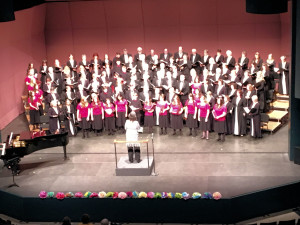
Music Director Laurie Anne Hunter leads Rogue Valley Chorale together with the youth Cantare Chorus in the performance of Portones Abiertos y Rostros Brillantes, by Paul Basler, during Rogue Valley Chorale’s Misa Azteca Concert, March 12, 2016 at Craterian Theatre, Medford, OR
Ms. Hunter chose to open the concert with a contemporary Spanish language piece, Portones Abiertos y Rostros Brillantes, by Paul Basler, set to a poem by California poet Gabriel Navar celebrating the excitement and joy of living, and sung by the Chorale in collaboration with the Chorale Association’s youth choir, the Cantare Chorus. It was indeed a very joyful and uplifting sounding work, especially with the addition of the young voices, and at roughly two minutes in length, a very apt way to commence this concert and get the audience in the mood for all that was to follow.
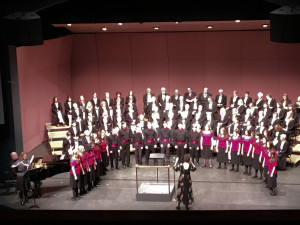
Music Director Shaun Garner leads the Cantare Chorus in a performance of the traditional Irish tune, The Gartan Mother’s Lullaby, with flute accompaniment by Marianne Franklin, during Rogue Valley Chorale’s Misa Azteca Concert, March 12, 2016 at Craterian Theatre, Medford, OR
After the opening number, the stage was turned over to the Cantare Chorus, directed by Shaun Garner and accompanied on piano by Jim Stickrod, which sang four more eclectic pieces: the Namibia folksong, Sipiri; the traditional Irish tune, The Gartan Mother’s Lullaby with flute accompaniment by Marianne Franklin; the Hungarian folksong, See the Gipsies; and the Hispanic folksong, El Coqui. The Cantare Chorus portion of the program was impressive, as well as lovely sounding. Ms. Garner had the youthful singers well prepared, singing with confidence and spirit – and sung from memory, without holding or referring to, any sheet music.
For the next portion of the program, the Cantare Chorus were followed to the stage by the dancers of the Ballet Folklorico Ritmo Allegre for four Danza Azteca dances. Ballet Folklorico Ritmo Allegre is a Medford-centered Mexican folk dance ensemble, which began its existence as a club at South Medford High School 20 years ago, but has evolved to become a nonprofit organization with a permanent dance studio located at Central Medford High School.
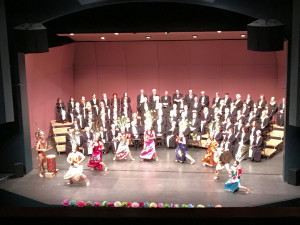
Ballet Folklorico Ritmo Allegre perform one of four Danza Azteca dances during Rogue Valley Chorale’s Misa Azteca Concert, March 12, 2016 at Craterian Theatre, Medford, OR
The company uses music, movement and colorful costumes to tell stories about regional Mexican culture, and has a special interest in Aztec dances. The Chorale’s collaboration with a dance company and inclusion of a dance portion in the concert was a novel addition to the Chorale’s concert offering, a part of the “paradigm shift” in the Chorale’s programming.
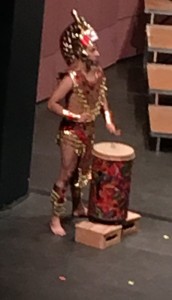
Ballet Folklorico drummer provides rhythmic beat for Danza Azteca dances performed by Ballet Folklorico Ritmo Allegre during Rogue Valley Chorale’s Misa Azteca Concert, March 12, 2016 at Craterian Theatre, Medford, OR
The very colorful and exuberant Ballet Folklorico dancers captivated the audience and commanded the stage with their intense rhythmic drum accompanied dance movements. After their sustained high-spirited burst of energy, an opportunity to pause and catch one’s breath was in order, so it was a very apt time for the intermission, before presenting the 8 movement Misa Azteca choral work for the second half of the program.
Before I comment in detail about the superlative and remarkable performance of the Misa Azteca work, I want to take a moment to discuss further the “paradigm shift” in the Chorale’s programming incorporated in the Misa Azteca concert. As one can gather from what I’ve already written, this concert included multiple collaborations, not just one or two, but a whole constellation of contributors – additional ensembles, dancers, instrumentalists, vocal soloists, and more, producing an integrated gestalt of an Aztec-themed program.

Art based on traditional Mexican Bark Painting created by students of Phoenix-Talent School District teachers Carmen Adams & Lori Mc Henry on display in the Craterian lobby as part of collaboration with Rogue Valley Chorale for Chorale’s Misa Azteca Concerts, March 12 & 13, 2016 at Craterian Theatre, Medford, OR
On top of everything else, the Chorale, with funding from the Medford Arts Commission collaborated with Phoenix-Talent School District teachers Carmen Adams and Lori Mc Henry on a project for their students to produce works of art based on traditional Mexican Bark Painting. The artwork was displayed in the Craterian lobby during the two Chorale Misa Azteca concert performances and then was moved to the Medford Library to be on display there for a while before being returned to the students who created it.
The resulting consequences of the “paradigm shift” in the Chorale’s programming, and the integrated Aztec-themed program it created, were profound, notable and immediately apparent. Prior to attending the Saturday, March 12 concert, I was worried about the size of the audience it would receive, because that weekend the Chorale was competing with an extraordinary number of other performing arts events attracting the Rogue Valley performing arts audience, including: a Rogue Valley Symphony fund raiser featuring a Metropolitan Opera soprano, an SOU Chamber and Concert Choir concert, a Jackson County Community Concert Association concert, a Daniel Chavez Quartet concert, performances of Oregon Cabaret Theatre’s Johnny Cash musical, Ring of Fire, Oregon Shakespeare Festival’s music infused productions of Twelfth Night and Yeoman of the Guard, as well as the dramas Great Expectations and River Bride, and Ashland Contemporary Theatre’s Red. I was afraid there was not going to be enough audience to go around, to fill the venue for the Chorale’s concerts. How wrong I was. Because of the “paradigm shift” in the Chorale’s programming, the Misa Azteca concert was different than any other choral or classical music concerts presented around here – AND it attracted a different audience, which practically filled the large Craterian venue. On Saturday evening, unlike at ALL the other performing arts events I attend in the Rogue Valley where the audience is primarily “white hairs” (senior affluent Caucasians), the Misa Azteca audience were predominantly millenials, not seniors – white hairs were sparse, and the audience was notably mixed, not just Caucasians. The novel and different approach to staging a concert by Ms. Hunter and the Chorale was brilliant, and a sea change for performing arts around here. The programming strategy and its result are something the rest of the local performing arts organizations, which are tapping out the “white hairs” in this area, can sit up and take notice of.
Now, finally, a few words about that performance of the new, original choral work, Misa Azteca. The work is truly wonderful, a modern masterpiece for choir, soloists, and instrumentalists, in the manner of earlier great choral works by composers like Bach, Mendelsohn, Handel, etc. The eight movements not only mirror elements of the structure of some of the earlier great choral masterpieces (e.g., a Kyrie, Gloria, Credo, Sanctus, Agnus Dei, Salve Regina, etc.) but they provide a an extensive, superlative and gratifying variety of choral singing dynamics, tempos, and stylings, as well as extraordinary solos and duets for soprano, tenor and mezzo soprano soloists, with varying accompaniments by piano, guitar and percussion. The entirety of the work, a 50 minute oratorio, would have been concert enough to be worth the price of a ticket, though the rest of the integrated program doubtless help attract the diverse and out-of-the-ordinary audience to the concert.
The first movement of Misa Azteca was a Kyrie, sung dramatically and passionately by the Chorale, accompanied deftly on the piano by accompanist Mikiko Petrucelli and with prominent and well done Aztec percussion by Theresa McCoy, which promptly made it clear to the audience that this was a choral work masterpiece that will enter the catalog of oft performed significant major choral works. With permission of the composer and the Chorale, I have a two minute excerpt recording of the conclusion of the Kyrie movement for you to hear and see for yourself:
https://youtu.be/RX2yYfSkV1A
The second movement was a Gloria which presented nice back and forth turns between the Chorale and the tenor soloist, Ricardo Garcia. The Chorale, once again, distinguished itself, singing beautifully, and Mr. Garcia contributed a rich tenor voice, well controlled and quite moving to hear.
The third movement was a lovely Gradual which featured soprano Katie Harman Ebner, whose performance on this movement was strikingly beautiful. The movement challenged the soloist with passages at the high end of a soprano’s range, and Ms. Ebner’s performance at the higher notes was impressive. The movement, utilizing both the choir and the soprano soloist, encompassed the full range of dynamics, from a quiet, pianissimo, sedate passage building to a loud, emphatic forte crescendo employing both the soloist and choir in full voices, and then settling down to a quiet conclusion. This movement again incorporated some exceptional Aztec drumming by Ms. McCoy.
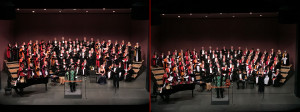
LEFT: Tenor Ricardo Garcia sings and Music Director Laurie Anne Hunter leads Rogue Valley Chorale in the performance of the 2nd movement (Gloria) of Joseph Julian Gonzalez’s Misa Azteca
RIGHT: Soprano Katie Harman Ebner sings and Music Director Laurie Anne Hunter leads Rogue Valley Chorale in the performance of the 3rd movement (Gradual) of Joseph Julian Gonzalez’s Misa Azteca, during Rogue Valley Chorale’s Misa Azteca Concert, March 12, 2016 at Craterian Theatre, Medford, OR
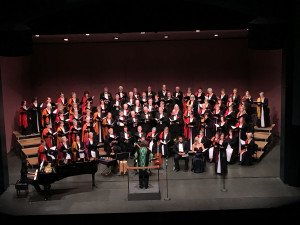
Mezzo-soprano Michelle Cipollone (standing) sings, with tenor Ricardo Garcia and soprano Katie Harman Ebner seated beside her during performance of 5th movement (Sanctus) of Joseph Julian Gonzalez’s Misa Azteca during Rogue Valley Chorale’s Misa Azteca Concert, March 12, 2016 at Craterian Theatre, Medford, OR
The fourth movement, the Credo, began with a gorgeous solo by tenor soloist, Mr. Garcia, with a prominent guitar accompaniment, performed by Grant Ruiz, followed by another lovely choral passage, sung exquisitely by the Chorale.
The fifth movement was a Sanctus, featuring a sublime blending of the soprano soloist (Ms. Ebner, again sung beautifully) and the Chorale, with an additional concluding solo by Mezzo-soprano Michelle Cipollone. The movement again incorporated prominent use of the Aztec drum by Ms. McCoy.
The sixth movement was a traditional and fine sounding Agnus Dei (“Lamb of God, who takes away the sins of the world, have mercy on us.”)
The seventh movement, the Salve Regina really accelerated the presentation, beginning with another passionate and well sung choral passage, before transitioning to a very beautiful, well matched, and exquisitely sung duet between soprano, Ms. Ebner and tenor, Mr. Garcia. Again with permission of the composer and the Chorale, I have a two and a quarter minute excerpt recording of the Chorale passage at the beginning of the Salve Regina for you to view:
https://youtu.be/cYKCpbbWBcs
The final movement of the piece was a glorious Ite Missa Est which incorporated a progressive series of passages providing participation by an extensive variety of contributors: the Chorale, of course, as well as tenor Mr. Garcia, and another Mezzo-soprano soloist, Ms. Janet O’Donovan, singing in sequence, various Alleluia choruses sandwiched around textual passages summing up the liturgical narratives and arc of the previous seven movements. It was again, moving, striking, glorious singing, worthy of the great choral masterpieces. I give you here the almost two minute finale of the movement (and thus, the work), so you might get a sense of, and appreciate, the majesty of it:
https://youtu.be/3SxGVGidhaI
At the conclusion of the performance, the audience erupted with a sustained, boisterous, standing ovation, and continued it through several bows and curtain calls, acknowledging in turn the soloists, the Chorale, the musicians, music director Ms. Hunter, eventually drawing the composer, Joseph Julian Gonzalez, up to the stage, and then even the directors of the Cantare Chorus, Ms. Garner, and of the Ballet Folklorico, Ms. Luisa Zaragoza. And even then, the applause continued for some time, only gradually dissipating.
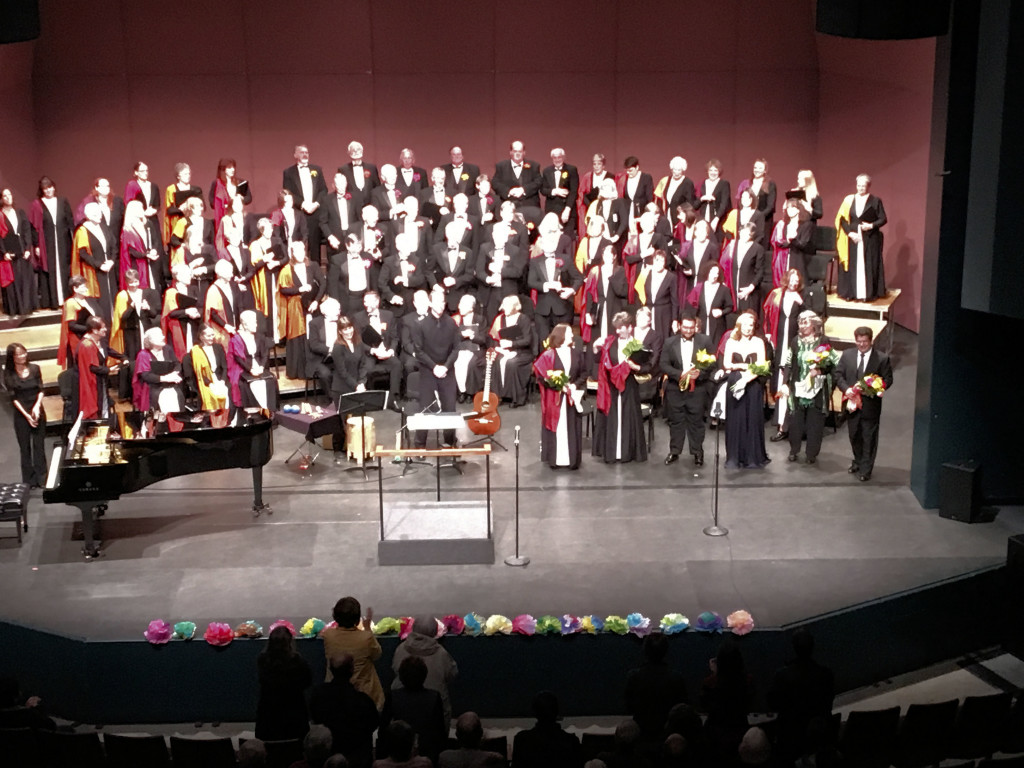
After the conclusion of the performance of Joseph Julian Gonzalez’s Misa Azteca the audience erupted into a sustained standing ovation which continued through multiple bows & curtain calls, here with pianist Mikiko Petrucelli (far left), percussionist Theresa McCoy (left center) guitarist Grant Ruiz (center) and at right (l-r) Mezzo-sopranos Michelle Cipollone & Janet O’Donovan, Tenor Ricardo Garcia, Soprano Katie Harman Ebner, Music Director Laurie Anne Hunter, and composer Joseph Julian Gonzalez joining the Chorale on stage at Rogue Valley Chorale’s Misa Azteca Concert, March 12, 2016 at Craterian Theatre, Medford, OR
In summary, the composition, Misa Azteca, was a fantastic and monumental new choral work, destined to be added to the repertoires of notable choirs worldwide, extremely well performed in this concert by a terrific collection of soloists and musicians and the Rogue Valley Chorale, pushed to the top of their form by Music Director Laurie Anne Hunter. It was the most interesting, entertaining & memorable Chorale concert in my time here in Southern Oregon (16 years & counting), and that encompasses quite a few memorable and prodigious concerts led by the great Lynn Sjolund. For the third concert of the 2015-2016 season, Ms. Hunter will again break new ground with the Chorale, once again offering an integrated collaborative effort with multiple contributors – this time a full contingent of area church choirs. The Rogue Valley Chorale’s Festival of Church Choirs will be presented in two performances at the Craterian Theatre at the Collier Center for the Performing Arts on Sunday, May 15 at 3:00 pm and 7:30 pm. For tickets: order online at http://www.craterian.org/, or call the box office at 541-779-3000, or in person at 16 S. Bartlett, Medford, OR 97501. Of course, I won’t be able to review THAT concert, since I’ll be singing in it with Michael Wing’s Westminster Presbyterian Church Choir.